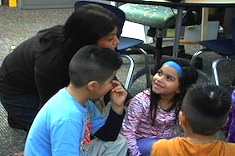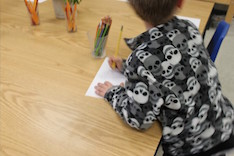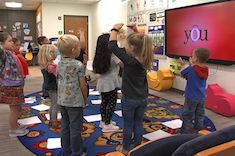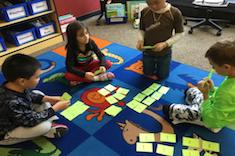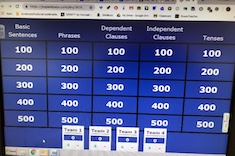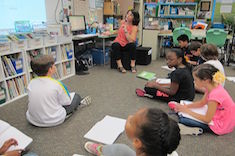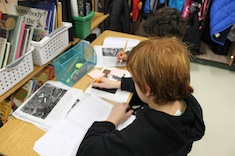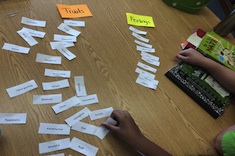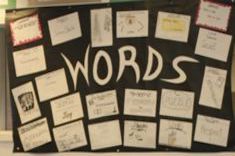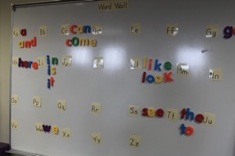Word Study and Vocabulary
Here is where you will find resources for teaching students about spelling, word features, vocabulary, and grammar.
Latest Content
Building Thinking Classrooms in Literacy
Inspired by Peter Liljedahl’s Building Thinking Classrooms in Mathematics, David Pittman applies instructional practices to get students thinking for themselves as readers and writers, and to be drivers, not consumers or mimickers of someone else’s way of doing things.
Harnessing the Power of Words
Tara Barnett and Kate Mills share three quick ways to increase vocabulary exposure in middle school. They also offer a summary of the importance of vocabulary development that inspires the urgency of vocabulary instruction.
Building Vocabulary One Purple Word at a Time
Leigh Anne Eck shares one way to uplift word choice of middle school writers. Through a simple and responsive system, her students are growing their vocabulary, learning parts of speech, and taking risks with more sophisticated word choice. All you need is a purple highlighter and a willingness to celebrate student voices.
Let’s Do It Again, Together
Heather Fisher revisits a whole-school vocabulary routine that she set in motion. In this update, she shares the ways she adjusted to work together as a team rather than fly solo. This might be just the school-wide vocabulary routine you’ve been craving.
Morning Message 3: Word Study and Conventions
There is much debate in today’s educational landscape around what and how to teach young readers about print. No matter what your classroom realities are around teaching how sounds, words, and language work, Ruth Metcalfe attests that using a morning message is an engaging way to support word study and conventions.
Weaving Words Throughout the School Year
Joanne Emery rounds up several ideas for embedding vocabulary routines in the school day. She also shares many rich vocabulary resources.
Partnering Phonics and Poetry
Jen Court gets creative with using materials for more than one skill to layer in additional phonics instruction and practice. Jen provides a guide to think critically about reusing resources throughout the day and across content areas. Download the Planning Tool for Phonics Lessons.
Eight Phonemic Awareness Activities for Morning Meeting
Lisa Mazinas suggests eight short phonemic awareness games that are quick and engaging word work opportunities.
Be the Teacher
Tammy Mulligan turns to her students for advice on how to make phonics lessons “sticky.” The Be the Teacher Center was created and has become a staple in her primary classroom.
Playing with Words
Heather Fisher considers the possibilities for extending vocabulary development through a daily word routine.
Fun with Sight Words
Heather Fisher describes the process of integrating sight word work into the existing curriculum.
Using Shared Writing to Nudge Students Toward Conventional Spelling
Mandy Robek shares the tools she uses to transition students to more conventional spelling.
Kindergarten: Sight Word Learning
Hayley Whitaker’s kindergartners spend their transition time learning sight words.
Quick and Easy Word Study Groups in First Grade
Bitsy Parks shares some of her favorite strategies for quick and meaningful word work groups in her first-grade classroom.
Grammar Games
Melanie Meehan shares two of her favorite games for teaching grammar, including templates and web resources.
The Importance of Correct Examples
Melanie Meehan explains why it is important to mentor students who are struggling with correct examples, and why she cautions writing teachers to avoid “find the mistakes” exercises.
Word Walls in Preschool? Yes, You Can!
A word wall in preschool?! Shari Frost helps a teacher meet this impossible edict, and has a lot of fun in the process thinking about how our youngest learners acquire word knowledge.
Quick Vocabulary Practice and Assessment
Gretchen Schroeder finds that any vocabulary routine eventually gets stale in her high school classroom. She shares a couple of favorite options for reinvigorating word learning.
Sentence Phrase Word: Student Independence for Word Learning
Andrea Smith uses the sentence-phrase-word thinking routine with her fourth graders to show how potent one word can be in understanding complex themes.
Student-Generated Vocabulary Discussions
Tara Barnett and Kate Mills find the key to middle school students attending to new vocabulary during read-alouds is to have students choose the words.
Toward More Meaningful Extension Activities
Shari Frost challenges assignments in reading workshop that kill a love of wordplay and vocabulary development.
Getting to Know Writers: Using Quotes
Dana Murphy concludes her series on getting to know writers with an activity on responding to quotes. This activity is a great baseline for gauging attitudes and previous experiences early in the year.
Alternatives to Daily Editing as a “Bell-Ringer” Activity
The “daily edit” is a common routine in many classrooms. Shari Frost explains why this may not be an effective way to teach conventions, and offers some alternatives.
Character Traits Through Word Sorts
Melanie Swider finds word sorts are a great way to help intermediate students master new vocabulary for describing character traits.
Building Word Learning Routines
Cathy Mere shares tried-and-true strategies for word learning with struggling young learners.
Vocabulary Instruction: Where to Start?
Gretchen Schroeder looks for new ways to help high school students learn words.
Holding a Dictionary
Jennifer Schwanke finds dictionaries (the real, not virtual, variety) are still a potent tool for teaching new vocabulary to children.
Tutoring Carl: Sketching to Draft
Max Brand challenges himself to let a student take more of the lead during a writing tutoring session.
Raising the Quality of Word Work
Shari Frost has some practical suggestions for more thoughtful word work.
The Power of Written Blind Word Sorts
Max Brand uses written blind word sorts to build student word learning skills.
Browse Content By
Type
Category
- Assessment Tools
- Big Fresh Archives
- Booklists
- Choice Numeracy
- Classroom Design
- Common Core
- Community Building
- Conferring
- Content Literacy
- Digital Literacy
- English Language Learners
- Equity
- Family Relations
- Free Samples
- Guiding Groups
- Leadership
- Literacy Coaches
- Mentor Texts
- Minilessons
- New Teacher Mentors
- Podcasts
- Poetry
- Quote Collections
- Reading Strategies
- Self Care
- Struggling and Striving Learners
- Talking and Listening
- Teacher Study Groups
- Teaching Reading
- Teaching Writing
- Word Study and Vocabulary
Author
- Melissa Quimby
- Nawal Qarooni
- Gwen Blumberg
- Julie Cox
- The Lead Learners
- Hannah Tills
- Josie Stewart
- Ruth Metcalfe
- Mallory Messenger
- Becca Burk
- Jodie Bailey
- Vivian Chen
- Mary Brower
- Stephanie Affinito
- Ruth Ayres
- Leigh Anne Eck
- Heather Fisher
- Shari Frost
- Julie Johnson
- Suzy Kaback
- Gigi McAllister
- Shirl McPhillips
- Melanie Meehan
- Cathy Mere
- Debbie Miller
- Tara Barnett and Kate Mills
- Tammy Mulligan
- Dana Murphy
- Bitsy Parks
- David Pittman
- Brenda Power
- Heather Rader
- Matt Renwick
- Mandy Robek
- Christy Rush-Levine
- Gretchen Schroeder
- Jen Schwanke
- Brian Sepe
- Katherine Sokolowski
- Stella Villalba
- Jennifer Vincent
Grade Level
Choice Literacy Membership
Articles
Get full access to all Choice Literacy article content
Videos
Get full access to all Choice Literacy video content
Courses
Access Choice Literacy course curriculum and training






